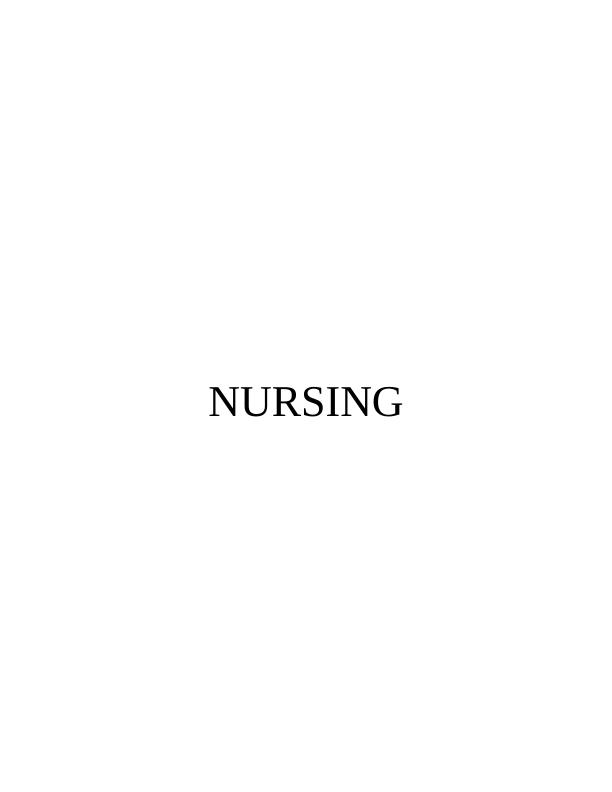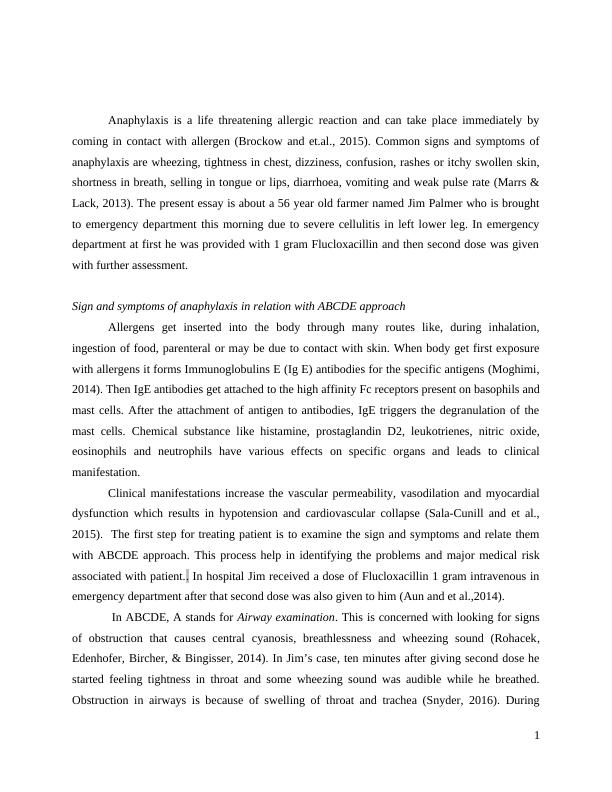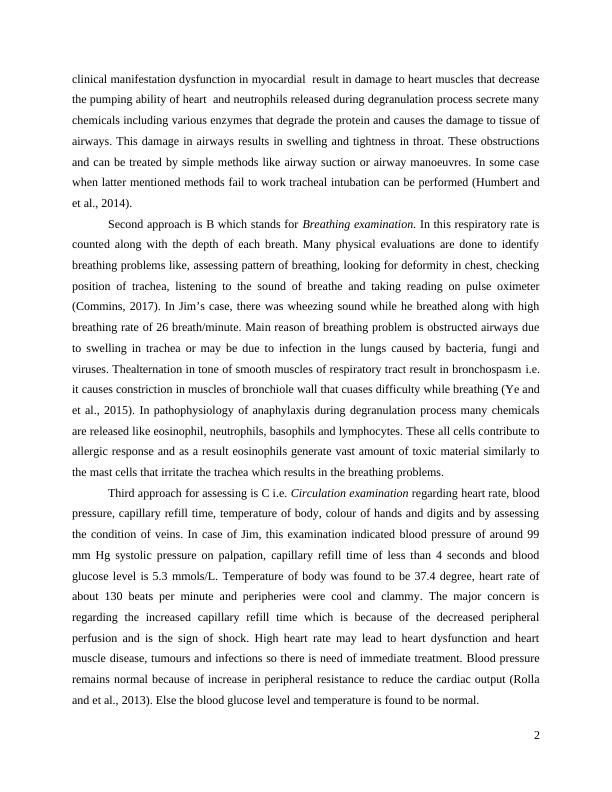Nursing Assignment on Anaphylaxis
Added on 2020-06-06
8 Pages2627 Words55 Views
NURSING

Anaphylaxis is a life threatening allergic reaction and can take place immediately bycoming in contact with allergen (Brockow and et.al., 2015). Common signs and symptoms ofanaphylaxis are wheezing, tightness in chest, dizziness, confusion, rashes or itchy swollen skin,shortness in breath, selling in tongue or lips, diarrhoea, vomiting and weak pulse rate (Marrs &Lack, 2013). The present essay is about a 56 year old farmer named Jim Palmer who is broughtto emergency department this morning due to severe cellulitis in left lower leg. In emergencydepartment at first he was provided with 1 gram Flucloxacillin and then second dose was givenwith further assessment.Sign and symptoms of anaphylaxis in relation with ABCDE approachAllergens get inserted into the body through many routes like, during inhalation,ingestion of food, parenteral or may be due to contact with skin. When body get first exposurewith allergens it forms Immunoglobulins E (Ig E) antibodies for the specific antigens (Moghimi,2014). Then IgE antibodies get attached to the high affinity Fc receptors present on basophils andmast cells. After the attachment of antigen to antibodies, IgE triggers the degranulation of themast cells. Chemical substance like histamine, prostaglandin D2, leukotrienes, nitric oxide,eosinophils and neutrophils have various effects on specific organs and leads to clinicalmanifestation.Clinical manifestations increase the vascular permeability, vasodilation and myocardialdysfunction which results in hypotension and cardiovascular collapse (Sala-Cunill and et al.,2015). The first step for treating patient is to examine the sign and symptoms and relate themwith ABCDE approach. This process help in identifying the problems and major medical riskassociated with patient.. In hospital Jim received a dose of Flucloxacillin 1 gram intravenous inemergency department after that second dose was also given to him (Aun and et al.,2014). In ABCDE, A stands for Airway examination. This is concerned with looking for signsof obstruction that causes central cyanosis, breathlessness and wheezing sound (Rohacek,Edenhofer, Bircher, & Bingisser, 2014). In Jim’s case, ten minutes after giving second dose hestarted feeling tightness in throat and some wheezing sound was audible while he breathed.Obstruction in airways is because of swelling of throat and trachea (Snyder, 2016). During1

clinical manifestation dysfunction in myocardial result in damage to heart muscles that decreasethe pumping ability of heart and neutrophils released during degranulation process secrete manychemicals including various enzymes that degrade the protein and causes the damage to tissue ofairways. This damage in airways results in swelling and tightness in throat. These obstructionsand can be treated by simple methods like airway suction or airway manoeuvres. In some casewhen latter mentioned methods fail to work tracheal intubation can be performed (Humbert andet al., 2014). Second approach is B which stands for Breathing examination. In this respiratory rate iscounted along with the depth of each breath. Many physical evaluations are done to identifybreathing problems like, assessing pattern of breathing, looking for deformity in chest, checkingposition of trachea, listening to the sound of breathe and taking reading on pulse oximeter(Commins, 2017). In Jim’s case, there was wheezing sound while he breathed along with highbreathing rate of 26 breath/minute. Main reason of breathing problem is obstructed airways dueto swelling in trachea or may be due to infection in the lungs caused by bacteria, fungi andviruses. Thealternation in tone of smooth muscles of respiratory tract result in bronchospasm i.e.it causes constriction in muscles of bronchiole wall that cuases difficulty while breathing (Ye andet al., 2015). In pathophysiology of anaphylaxis during degranulation process many chemicalsare released like eosinophil, neutrophils, basophils and lymphocytes. These all cells contribute toallergic response and as a result eosinophils generate vast amount of toxic material similarly tothe mast cells that irritate the trachea which results in the breathing problems. Third approach for assessing is C i.e. Circulation examination regarding heart rate, bloodpressure, capillary refill time, temperature of body, colour of hands and digits and by assessingthe condition of veins. In case of Jim, this examination indicated blood pressure of around 99mm Hg systolic pressure on palpation, capillary refill time of less than 4 seconds and bloodglucose level is 5.3 mmols/L. Temperature of body was found to be 37.4 degree, heart rate ofabout 130 beats per minute and peripheries were cool and clammy. The major concern isregarding the increased capillary refill time which is because of the decreased peripheralperfusion and is the sign of shock. High heart rate may lead to heart dysfunction and heartmuscle disease, tumours and infections so there is need of immediate treatment. Blood pressureremains normal because of increase in peripheral resistance to reduce the cardiac output (Rollaand et al., 2013). Else the blood glucose level and temperature is found to be normal. 2

End of preview
Want to access all the pages? Upload your documents or become a member.
Related Documents
Type of Asthma: Allergic Asthma in a Six-Year-Old Childlg...
|5
|1500
|186
Showing Various Clinical Manifestationslg...
|9
|2093
|30
ASSIGNMENT ON PATHOPHYSIOLOGY AND PHARMACOLOGY.lg...
|13
|3607
|16
